Passare da WordPress.com a WordPress.org potrebbe sembrare spaventoso, ma è una delle migliori decisioni che puoi prendere per il futuro del tuo blog.
Abbiamo costruito tutti i nostri siti web su WordPress.org e guidato innumerevoli clienti attraverso questo importante passaggio. Ognuno di loro ci ha detto che la ritrovata libertà ne vale la pena.
La differenza è abissale. Con WordPress.org, non sei bloccato con temi limitati o opzioni di monetizzazione ristrette. Puoi installare qualsiasi plugin, personalizzare completamente il tuo design e trasformare il tuo blog in un vero business.
Abbiamo visto troppi blogger lottare con le restrizioni di WordPress.com. Ecco perché abbiamo messo insieme questa guida passo passo per rendere la tua migrazione il più agevole possibile. Sarai stupito di ciò che puoi realizzare una volta che passerai a WordPress.org.
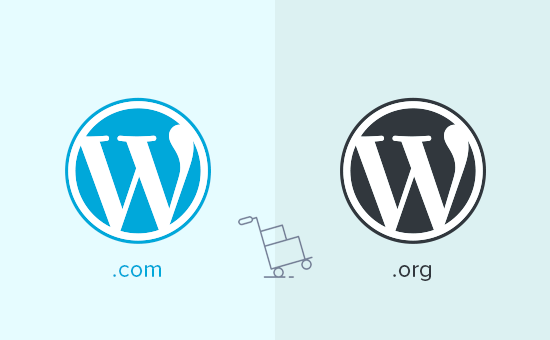
Perché passare da WordPress.com a WordPress.org?
WordPress.com permette a chiunque di avviare un blog creando un account gratuito. Questo rende facile per i principianti iniziare a bloggare rapidamente senza affrontare problemi tecnici.
Tuttavia, molti utenti si rendono conto che il loro blog gratuito su WordPress.com presenta alcune limitazioni. Queste includono la limitata capacità di monetizzare, l'impossibilità di installare plugin, annunci di terze parti visualizzati agli utenti e altro ancora.
Questo è il motivo per cui gli utenti passano spesso alla piattaforma self-hosted WordPress.org, più potente e popolare. In alternativa, potresti passare a un piano a pagamento di WordPress.com.
Abbiamo confrontato WordPress.com e WordPress.org in modo approfondito. Questa analisi affiancata spiega le differenze, i vantaggi e gli svantaggi di entrambe le piattaforme.
Ti consigliamo di utilizzare WordPress.org perché ti dà la piena proprietà del tuo sito web e la libertà di controllare tutte le sue funzionalità. Per saperne di più su tutte queste funzionalità, consulta la nostra recensione completa di WordPress con pro e contro.
Detto questo, vediamo come migrare correttamente il tuo blog da WordPress.com a WordPress.org.
Cose di cui hai bisogno prima di iniziare
Per iniziare con WordPress.org self-hosted, avrai bisogno di un account di hosting WordPress e di un nome di dominio.
Ti consigliamo Bluehost perché è una delle più grandi società di hosting al mondo e un provider di hosting WordPress ufficialmente raccomandato.

Stanno anche offrendo agli utenti di WPBeginner un nome di dominio gratuito e un enorme sconto sull'hosting web. Puoi iniziare a partire da $2.99 / mese (e questo include anche SSL gratuito).
Avrai comunque bisogno di un hosting web se il tuo sito WordPress ha un nome di dominio personalizzato. Vai avanti e iscriviti con Bluehost, e sotto il passaggio del dominio, aggiungi il dominio del tuo blog.
Nei passaggi successivi, ti mostreremo come mantenere lo stesso dominio durante il trasferimento da WordPress.com a WordPress.org senza perdere il posizionamento nei motori di ricerca.
Oltre all'account di hosting, avrai anche bisogno dell'accesso al tuo account WordPress.com per trasferire facilmente i tuoi post, pagine, immagini, commenti e altri dati al tuo sito WordPress self-hosted.
Offerta Bonus Gratuita: Poiché molti di voi l'hanno richiesta, ora offriamo un servizio di migrazione gratuito da WordPress.com a WordPress.org come parte del nostro servizio di configurazione gratuita del blog WordPress. Durante questo trasferimento guidato, uno dei membri del nostro team di esperti eseguirà l'intera migrazione per te (100% gratuito). Ciò significa che puoi passare da WordPress.com a WordPress.org senza alcun rischio.
Tuttavia, se ti piace imparare e fare le cose da solo, puoi seguire il nostro tutorial passo dopo passo qui sotto. Ecco una rapida panoramica di tutti i passaggi che copriremo.
- Passaggio 1: Esportazione dei dati da WordPress.com
- Passaggio 2: Configurazione di WordPress
- Passaggio 3: Importazione dei contenuti in un sito WordPress self-hosted
- Fase 4: Importazione dei link del blogroll
- Fase 5: Impostazione del tuo blog WordPress.com su privato
- Fase 6: Reindirizzamento dei visitatori e conservazione della SEO
- Tutorial video
- Domande frequenti (FAQ)
Ci siamo!
Passaggio 1: Esportazione dei dati da WordPress.com
Innanzitutto, devi accedere al tuo sito WordPress.com e andare alla dashboard del tuo account.
Da lì, dovrai passare alla visualizzazione WP Admin per il blog o il sito web che desideri migrare. Fai semplicemente clic sul menu a tre punti accanto al nome del tuo sito e quindi seleziona WP Admin.
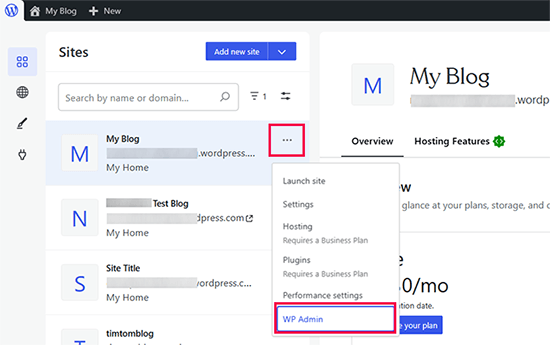
Questo ti porterà alla tradizionale dashboard di amministrazione di WordPress.
Dalla colonna di sinistra, devi fare clic sul menu Strumenti » Esporta e quindi fare clic sul pulsante 'Esporta tutto'.
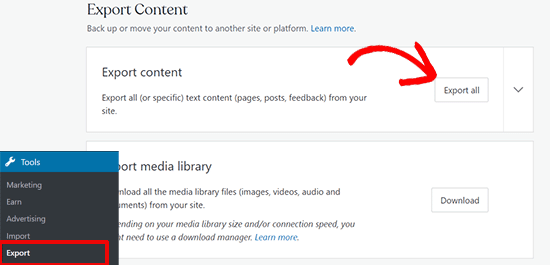
Questo ti permette di esportare il tuo sito WordPress. Una volta che il file di esportazione è pronto, sarà visibile un link per il download. Puoi fare clic per scaricare il file zip sul tuo computer.
WordPress.com invierà anche il link al tuo indirizzo email.
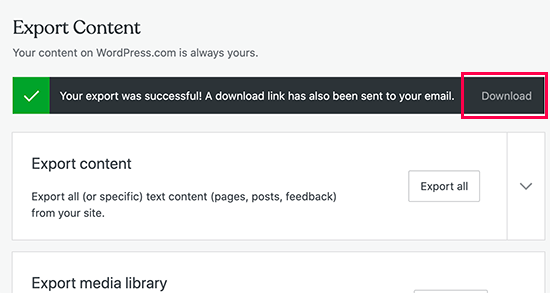
Una volta scaricato il file sul tuo computer, dovrai decomprimerlo.
Al suo interno, troverai un file XML con tutti i tuoi post, pagine, immagini, commenti, campi personalizzati, categorie, tag, menu di navigazione e altri dati.
Passaggio 2: Configurazione di WordPress
Ora che hai esportato i tuoi dati da WordPress.com, il passaggio successivo è configurare una nuova installazione di WordPress sul tuo hosting web.
WordPress è molto facile da installare e richiede solo pochi clic. Se ti sei registrato con Bluehost come menzionato sopra, WordPress verrà installato automaticamente per te.
In alternativa, se scegli un altro servizio di hosting, puoi seguire il nostro tutorial passo passo su come installare WordPress in 5 minuti.
Una volta installato WordPress, è ora di importare i tuoi contenuti nel tuo nuovo sito web WordPress self-hosted.
Passaggio 3: Importazione dei contenuti in un sito WordPress self-hosted
Per importare i contenuti del tuo vecchio sito WordPress.com sul tuo nuovo sito WordPress.org, dovrai accedere all'area amministratore del tuo sito WordPress appena installato.
Da qui, devi visitare la pagina Strumenti » Importa e fare clic sul pulsante 'Installa ora' sotto WordPress.
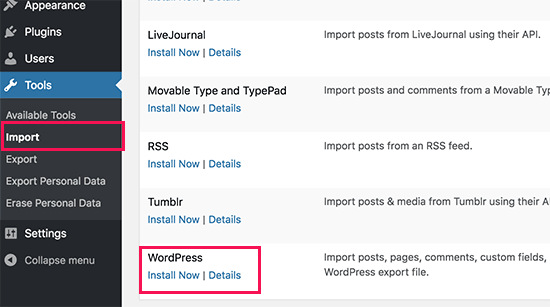
WordPress installerà ora l'importatore di WordPress per te.
Una volta completato, fai clic sul link 'Esegui importatore' per continuare.
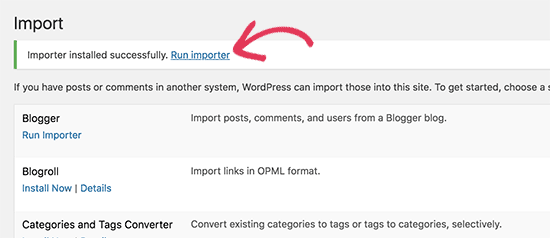
Ti porterà a una schermata in cui ti verrà chiesto di caricare il file XML di WordPress.com che hai scaricato nel passaggio 1 di questo tutorial.
Fai clic sul pulsante 'Scegli file' per selezionare il file, quindi fai clic sul pulsante 'Carica file e importa'.
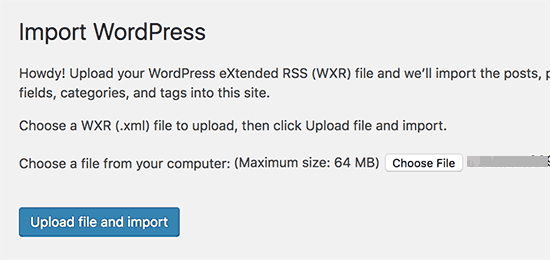
☝ Nota: Se la dimensione del tuo file è superiore a 2 MB, hai due opzioni. Una è chiedere alla tua società di hosting web di aumentare temporaneamente quel limite in modo da poter procedere con il processo. L'altra opzione è dividere il tuo file utilizzando uno strumento per dividere file WXR.
Quando inizi l'importazione, puoi assegnare i contenuti importati a un utente esistente o crearne uno nuovo.
Avrai anche l'opzione di importare gli allegati dei file. Devi selezionare questa casella in modo che i tuoi file immagine vengano importati correttamente.
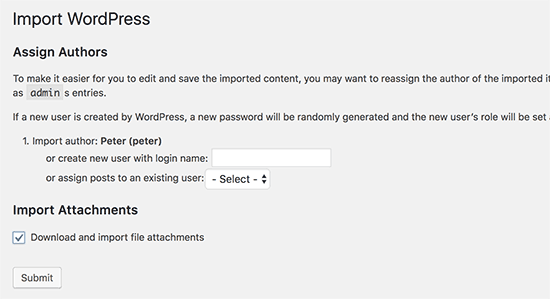
Fase 4: Importazione dei link del blogroll
Se hai utilizzato la funzione Link sul tuo blog WordPress.com per archiviare il blogroll o altri link, allora devi seguire queste istruzioni per importarli. Gli utenti che non hanno utilizzato questa funzione possono passare al passaggio 5.
WordPress non supporta nativamente la funzione blogroll. Se non hai troppi link nel tuo blogroll, consulta la nostra guida su come aggiungere link blogroll in WordPress senza utilizzare un plugin.
Tuttavia, se hai troppi link o desideri mantenere la funzionalità del blogroll, continua a leggere.
I link del blogroll vengono esportati in formato OPML. È un formato XML che ti consente di esportare e importare i tuoi link e le categorie di link. I tuoi link di WordPress.com hanno un file OPML situato a un indirizzo simile a questo:
http://example.wordpress.com/wp-links-opml.php
Sostituisci l'esempio con il sottodominio del tuo blog WordPress.com.
Se stai utilizzando un dominio personalizzato con il tuo sito web WordPress.com, il tuo file OPML sarà accessibile visitando un URL simile a questo:
http://www.example.com/wp-links-opml.php
Il tuo file OPML si aprirà nella finestra del browser e dovrai salvarlo sul tuo desktop. Premi CTRL+S (Comando+S su Mac) per salvare il file sul tuo computer.
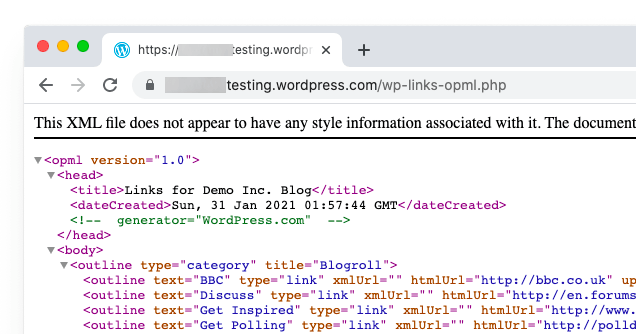
Ora che hai un backup dei tuoi link WordPress.com, il passo successivo è importarli in WordPress. Tuttavia, WordPress self-hosted non ha un gestore di link abilitato per impostazione predefinita.
Dovrai installare e attivare il plugin Link Manager. La pagina del plugin indica che non è stato aggiornato per molti anni. Questo perché non aveva bisogno di aggiornamenti e puoi installare questo plugin con fiducia.
Dopo l'attivazione, il plugin aggiungerà una nuova voce di menu etichettata 'Link' alla tua barra di amministrazione di WordPress.
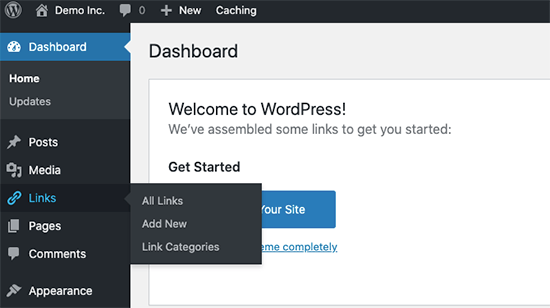
Successivamente, devi installare e attivare il plugin OPML Importer. Questo plugin abilita un nuovo strumento di importazione che ti consente di importare i link del blogroll.
Dopo l'attivazione, devi visitare la pagina Strumenti » Importa e fare clic sul link 'Esegui importatore' sotto l'importatore Blogroll.
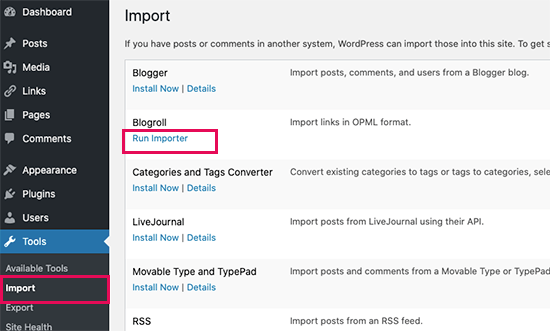
Nella pagina dell'importatore Blogroll, devi caricare il file OPML che hai salvato in precedenza.
Fai clic sul pulsante 'Scegli file' per selezionare il file, quindi fai clic sul pulsante 'Importa file OPML' per continuare.
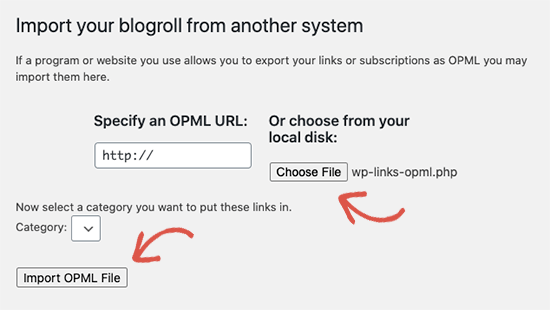
WordPress importerà ora i tuoi link e le categorie di link dal file OPML.
Sarai in grado di vedere il progresso e, al completamento, vedrai il messaggio di successo.
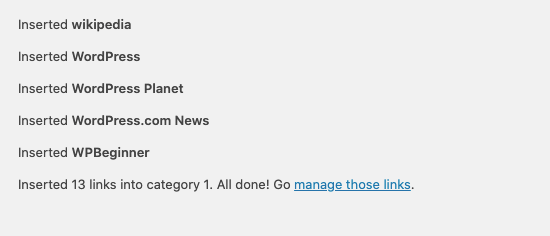
Fase 5: Impostazione del tuo blog WordPress.com su privato
Ora, se non vuoi reindirizzare i tuoi vecchi utenti al tuo nuovo sito, questo sarà il tuo ultimo passaggio.
Innanzitutto, visita la dashboard di WordPress.com del tuo vecchio blog. Dal menu di sinistra, devi fare clic sul menu Impostazioni » Generali e scorrere fino alla sezione ‘Privacy’.
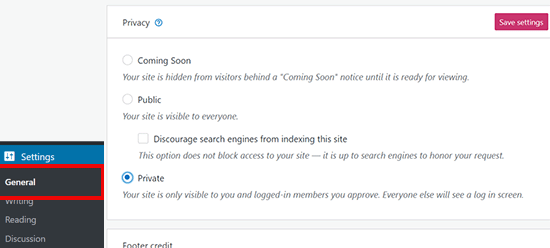
Da qui, devi selezionare l’opzione ‘Privato’ e quindi fare clic sul pulsante ‘Salva impostazioni’.
Questo renderà privato il tuo vecchio blog WordPress.com e sarà visibile solo a te o ad altri utenti connessi che approvi.
Attenzione: Se scrivi da tempo e hai un pubblico fedele, non ha senso lasciarli in sospeso.
Inoltre, se il tuo blog è online da un po' di tempo, è probabile che sia indicizzato da Google e da altri motori di ricerca.
Puoi mantenere tutte le classifiche dei motori di ricerca e reindirizzare facilmente i tuoi vecchi utenti al tuo nuovo blog seguendo il Passaggio 6 (altamente raccomandato se il tuo sito è consolidato).
Fase 6: Reindirizzamento dei visitatori e conservazione della SEO
Reindirizzare gli utenti alla nuova posizione con l'header 301 è una soluzione standard per mantenere le classifiche di ricerca durante lo spostamento di un sito da un luogo all'altro.
Poiché non hai accesso al file .htaccess su WordPress.com, non puoi apportare modifiche per mantenere le classifiche dei motori di ricerca.
Tuttavia, WordPress.com offre una funzionalità di upgrade a pagamento chiamata ‘Reindirizzamento sito’, che fornisce questa funzionalità.
Vai semplicemente alla pagina Reindirizzamento sito. Se hai più siti su WordPress.com, ti verrà chiesto quale desideri reindirizzare.
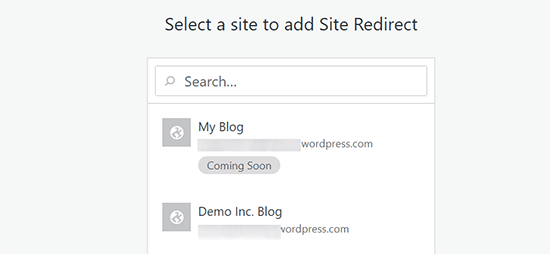
Nella schermata successiva, ti verrà chiesto di fornire il nome di dominio dove vuoi che i visitatori vengano reindirizzati. Inserisci il nome di dominio del tuo nuovo sito WordPress.org e fai clic sul pulsante vai.
☝ Nota: Il reindirizzamento del sito è un aggiornamento a pagamento e costa $13 all'anno. Aggiungerà un reindirizzamento 301, che reindirizza i visitatori del tuo blog WordPress.com e i motori di ricerca al tuo nuovo sito.
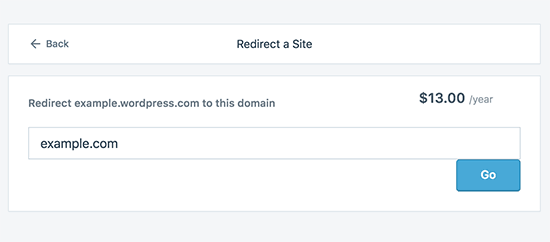
Alcuni di voi si chiederanno: per quanto tempo dovrò continuare a pagare per questa funzionalità di reindirizzamento esterno?
La risposta è per tutto il tempo che desideri. Tuttavia, due anni sarebbero sufficienti per permettere ai tuoi vecchi utenti di memorizzare il tuo nuovo nome di dominio.
Se stai cambiando dominio, un'altra cosa che vorrai fare è aggiornare tutti gli URL all'interno dei post. Se hai mai collegato tra loro i tuoi post, quei link devono essere aggiornati. Puoi usare il nostro articolo su come aggiornare gli URL quando si sposta il sito WordPress.
Se hai un dominio personalizzato su WordPress.com, non devi preoccuparti. Ti basta cambiare il record DNS verso il tuo host e manterrai tutti i vantaggi SEO.
Tutorial video
Hai bisogno di vedere il processo in ancora più dettaglio? Ecco un tutorial video passo passo su come migrare da WordPress.com a WordPress.org:
Domande frequenti (FAQ)
Abbiamo scritto la prima versione di questo articolo nel gennaio 2013, che è parecchio tempo fa! Ma lo aggiorniamo regolarmente per assicurarci di fornirti le informazioni più aggiornate.
Detto questo, da allora abbiamo ricevuto tonnellate di ottime domande. Ne abbiamo risposte molte via email o nei commenti, quindi abbiamo pensato che sarebbe stato bello raccogliere quelle più popolari in un unico posto dove tutti potessero vederle.
Cosa succede ai miei iscritti di WordPress.com?
Fortunatamente, WordPress.com ti permette di migrare i tuoi iscritti a una condizione. Devi usare il loro plugin Jetpack, che aggiunge la stessa funzionalità di iscrizione che avevi su WordPress.com.
Una volta installato e attivato il plugin Jetpack, dovrai contattare il team di WordPress.com e chiedere loro di migrare gli iscritti per te. Speriamo che questo diventi più facile nelle versioni future di Jetpack e che gli utenti possano farlo da soli.
Puoi aiutarmi a trasferirmi da WordPress.com a WordPress.org GRATIS?
Absolutely. We offer migration from WordPress.com as part of our free WordPress blog setup service. If you need our assistance, then simply sign up. It’s free ![]()
Quali sono i costi per passare a WordPress.org?
WordPress è gratuito. Tuttavia, ci sono alcuni costi minimi di hosting web. Ti consigliamo di leggere questo articolo su: Perché WordPress è gratuito? Quali sono i costi e qual è il trucco?
Ho già pagato WordPress.com. Posso ottenere un rimborso?
Sì, puoi. Se hai acquistato di recente un dominio personalizzato o un piano a pagamento da WordPress.com, puoi chiedere loro un rimborso completo.
Nota: le registrazioni dei domini possono essere annullate entro 48 ore dalla registrazione, mentre i piani e altri acquisti possono essere annullati entro 30 giorni dall'acquisto.
Le mie immagini si romperanno?
No, non lo faranno. Quando trasferisci utilizzando il file di importazione, tutte le immagini allegate vengono scaricate e il collegamento viene aggiornato.
Tuttavia, abbiamo notato un'avvertenza. Se l'URL della tua immagine inizia con files.wordpress.com, non verranno convertite. Se noti che l'URL dell'immagine non è cambiato e punta ancora a WordPress.com, ti consigliamo di utilizzare il plugin per importare immagini esterne, che se ne occuperà.
Ho registrato il mio dominio tramite WordPress.com. Posso ancora spostarmi?
Sì, puoi. WordPress crede nel dare potere agli utenti e nel dare loro il pieno controllo dei propri contenuti. Se hai già un nome di dominio tramite WordPress.com, tutto ciò di cui hai bisogno è un account di web hosting.
Ti consigliamo di configurare il tuo sito con Bluehost o uno qualsiasi di questi altri provider di hosting WordPress. Durante la fase di registrazione, ti verrà chiesto se hai già un dominio o se desideri registrarne uno nuovo.
Seleziona semplicemente l'opzione 'Ho un nome di dominio' e inserisci il dominio che hai registrato su WordPress.com.
La prossima cosa che dovrai fare è cambiare i nameserver per puntare al provider di hosting. Possiamo assisterti in questo come parte del nostro servizio di configurazione gratuito. Puoi anche chiedere supporto al tuo provider di web hosting.
Il mio sito web andrà offline quando cambierò?
Se lo fai correttamente, allora NO. Il metodo che abbiamo suggerito sopra garantirà che il tuo sito web non vada mai offline. Se sei preoccupato, sappi che siamo qui per aiutarti. Sei il benvenuto a utilizzare il nostro servizio di configurazione gratuito in qualsiasi momento.
Posso aggiungere un negozio online al mio sito WordPress.org?
Sì, puoi facilmente aggiungere un negozio online al tuo sito WordPress.org self-hosted senza costi aggiuntivi. Poiché Bluehost e altri provider di hosting web popolari offrono certificati SSL gratuiti, devi semplicemente installare un plugin eCommerce per WordPress per aggiungere un negozio online.
Quali sono alcuni dei plugin WordPress indispensabili che raccomandi?
Ora che sei passato a WordPress.org self-hosted, puoi installare tutti i plugin che desideri.
Ecco la nostra scelta consigliata:
- AIOSEO – per migliorare il posizionamento SEO del tuo sito web (utilizzato da 3 milioni di siti).
- WPForms – per aggiungere un modulo di contatto intelligente al tuo sito web (utilizzato da 6 milioni di siti).
- SeedProd – per personalizzare facilmente le tue landing page con un builder drag & drop – funziona con tutti i temi WordPress.
- MonsterInsights – per vedere come le persone trovano e utilizzano il tuo sito web. È un must per blogger e proprietari di piccole imprese.
- PushEngage – per connetterti con i visitatori dopo che hanno lasciato il tuo sito web.
- Duplicator – per creare backup giornalieri del tuo nuovo sito web in caso di emergenza.
- OptinMonster – per aiutarti a ottenere più iscritti via email e avere successo nel tuo percorso di blogging.
Oltre a questi, ti consigliamo di dare un'occhiata alla nostra selezione di esperti dei plugin WordPress indispensabili e strumenti utili per il blogging per gestire e far crescere il tuo blog.
Puoi installare tutti questi plugin direttamente dalla tua bacheca di WordPress. Abbiamo creato una guida passo passo su come installare un plugin WordPress.
Voglio cambiare il tema WordPress del mio sito, posso farlo?
Sì, puoi cambiare il tuo tema WordPress in qualsiasi momento. Un altro grande vantaggio del passaggio a WordPress.org è che ottieni opzioni di personalizzazione aggiuntive e una collezione più ampia di temi tra cui scegliere.
Nella barra laterale di amministrazione di WordPress, fai clic sul menu a discesa Aspetto e seleziona 'Temi' per installare un tema.
Abbiamo selezionato alcuni dei migliori temi per aiutare gli utenti a evitare la paralisi da scelta. Consulta la nostra guida sui migliori temi gratuiti per blog WordPress e sui migliori temi multiuso per WordPress.
Potresti anche voler consultare la nostra guida su come cambiare correttamente un tema WordPress.
Speriamo che questo articolo ti abbia aiutato a spostare correttamente il tuo blog da WordPress.com a WordPress.org. Potresti anche voler consultare la nostra checklist delle cose più importanti da fare dopo aver installato WordPress e la nostra guida definitiva su come aumentare il traffico del tuo blog.
Se ti è piaciuto questo articolo, iscriviti al nostro canale YouTube per tutorial video su WordPress. Puoi anche trovarci su Twitter e Facebook.





Inge
Ciao,
Ho seguito tutti i passaggi del tutorial per spostare il mio sito web WordPress.com già completato su un sito web WordPress.org, utilizzando un nuovo nome di dominio e host. Tutto sembra esattamente uguale al video e sembrava funzionare, tranne alla fine... dopo aver importato il file esportato dal mio WordPress.com al mio WordPress.org, non vedo apparire il mio sito web come ero abituato quando era ancora un sito WordPress.com... Invece vedo una pagina 'hello world', in cui sembra che debba ricominciare tutto da capo per creare il sito web. Devo installare un plugin per questo? Mi costa denaro in entrambi i casi spostare il mio sito web WordPress.com sul mio dominio? (su cui ho installato WordPress?) Sembra che le pagine siano state importate con successo, ma non vedo alcun contenuto. Nessuna immagine, nessun testo... Qualcuno può aiutarmi?
Grazie!
Inge
Staff editoriale
Ciao Inge,
Ciò significa che la tua importazione è fallita. Saremmo felici di aiutarti se sei ancora idoneo al nostro servizio di configurazione gratuito.
Amministratore
Staff di WPBeginner
Joe, ci dispiace per questo. Sfortunatamente i 'mi piace' di Jetpack non sono trasferibili.
Joe Johnston
Ho seguito le istruzioni di questo tutorial. Ho acquistato un nome di dominio e un piano di hosting e ho trasferito il mio blog wp.com lì secondo queste istruzioni. Ho anche acquistato un reindirizzamento del sito di 1 anno. Tutto ha funzionato, tranne tutti i 'mi piace' che i miei post avevano non vengono più visualizzati. Vorrei che questo tutorial lo avesse menzionato, altrimenti non avrei trasferito il mio wp.com e pagato per il reindirizzamento del sito solo per avere un mucchio di post che sembrano non essere mai piaciuti a nessuno. Sono davvero deluso, in particolare da Jetpack e dall'intero sistema WordPress che tutto possa essere trasferito tranne i 'mi piace'. Non ha senso...
Staff di WPBeginner
Non se stai usando lo stesso dominio con la stessa struttura dei permalink.
Staff di WPBeginner
Puoi installare WordPress sul tuo computer, ma non potrai accedervi utilizzando il tuo nome di dominio. Per quello dovrai passare a un server live.
Terry
Ho il mio dominio, ma ancora nessun hosting. Posso creare il mio sito wordpress.org senza avere già l'hosting?
Grigio
Ciao!
Avevo una domanda a cui non riesco a trovare risposta –
Se hai un nome di dominio personalizzato su Wordpress.com e lo cambi in .org, manterrà il suo posto nei ranking di Google? E quindi c'è bisogno di pagare per il reindirizzamento?
Scusa se è una domanda stupida.
Ricardo P Aquino
Scommetto che questo è il tuo articolo più letto. Grazie per il post! Sono nel bel mezzo di questo preciso processo e il tuo sito aveva TUTTE le informazioni di cui potrei aver bisogno per farlo.
Grazie!
Staff di WPBeginner
Nessun utente vedrà un sito WordPress con un post di "hello world". Se vuoi, puoi mettere il tuo sito WordPress self-hosted in modalità manutenzione.
Emma
Ciao! Domanda: sto creando un nuovo sito per un cliente e loro vogliono trasferire il loro blog Wordpress.com SOLO nella pagina "Blog" di un nuovo sito Wordpress.org che ho creato per loro. L'importazione del file xml di wordpress.com sovrascriverà tutto il lavoro che ho fatto per creare le altre pagine sul sito Wordpress.org? Oppure è possibile importare il blog di wordpress.com SOLO per la nuova pagina "Blog"?
Staff di WPBeginner
Importare contenuti nel tuo sito WordPress.org self-hosted non eliminerà nulla di ciò che hai aggiunto prima di eseguire l'importazione.
Charles Cornelius
Grazie per l'articolo, ma mi sono perso al passaggio 3. Sono sicuro che sono molto lento.
Ho fatto i passaggi 1 e 2. Il passaggio 3 mi sembra più un salto, non un passaggio, perché chiaramente c'è più tra i passaggi 2 e 3 di quanto sembri.
Innanzitutto, dov'è la mia dashboard di WordPress sul mio sito self-hosted? (Sto usando Blue Host e ho installato WordPress su di esso - anche se nel cPanel ho ancora l'opzione per installare WordPress lì). La dashboard di WordPress non è sul cPanel - presumibilmente devo accedervi tramite il miodominio.com/wp-admin, ma questo significa che devo prima reindirizzare i nameserver da wordpress.com a bluhost? (Ho già un dominio per il mio sito a cui wordpress.com reindirizza).
Sicuramente ciò significa che chiunque visiti il mio sito vedrà una pagina bianca finché non avrò caricato il file xml e installato un tema.
Quindi quali sono i sotto-passaggi tra i passaggi 2 e 3?
Staff di WPBeginner
Assicurati che i nameserver del tuo dominio puntino a Bluehost e non a WordPress.com
Potresti anche voler aggiornare gli URL del sito.
Alex Ekkelenkamp
Ho un piccolo problema. Ho trasferito il mio dominio da WP.com a Bluehost e ho installato WordPress. Tuttavia, il mio link di amministrazione continua a riportarmi alla mia dashboard di wordpress.com invece che a wordpress.org. Ora il mio sito non si carica affatto. Cosa ho sbagliato?
Alex Ekkelenkamp
Mi sento un po' bloccato, purtroppo. Ho trasferito il mio dominio, installato WordPress su Bluehost e acceduto alla mia dashboard. Tuttavia, è ancora la dashboard di WordPress.com invece di WordPress.org. Non sono sicuro di cosa sia andato storto!
Staff di WPBeginner
Puoi riprovare, l'importatore è abbastanza intelligente da non creare contenuti duplicati.
Laureen
Ho effettuato un trasferimento da wordpress.com a wordpress.org durante il fine settimana. Sono riuscito ad esportare il contenuto del blog, ma ho notato l'altro giorno che non tutti i commenti sono stati trasferiti. Potrebbe essere un problema? Ho selezionato "Tutto il contenuto" sull'esportazione.
Saleem
Grazie per un articolo così bello! Ho una domanda. Ho il mio dominio per il mio account wordpress.com, quando passerò all'hosting autonomo e farò puntare il mio dominio al nuovo host, manterrò il mio posizionamento nella ricerca su Google o dovrò ricostruirlo da capo? Grazie.
Staff di WPBeginner
Manterrai i tuoi posizionamenti se la struttura del tuo URL rimarrà la stessa.
Staff di WPBeginner
Sì, se il tema che stai utilizzando è un tema gratuito disponibile per l'uso su siti WordPress self-hosted.
Suzanne
Ho una domanda. Se ho degli iscritti che ricevono automaticamente gli aggiornamenti del mio blog, dovrei comunque acquistare un reindirizzamento? I miei iscritti non riceverebbero automaticamente il mio nuovo indirizzo web via email? Se poi rispondessero via email, andrebbe al nuovo sito o no?
Grazie per la tua risposta.
Suzanne
Harriet Southall
Ciao, procederò con il tuo servizio di configurazione gratuito per spostare il nostro blog – mi sembra un ottimo servizio! Volevo solo verificare, il layout e il tema del blog rimarranno esattamente gli stessi di quelli attuali sul sito live? Il blog è grazie mille per il tuo aiuto!
Staff di WPBeginner
Nome di dominio e hosting sono due servizi diversi. Puoi mantenere il tuo nome di dominio WordPress.com e usarlo con il tuo sito WordPress self-hosted. Sì, puoi ancora beneficiare del nostro servizio di configurazione gratuito del blog.
Cath
Un articolo fantastico! Adoro anche l'illustrazione!
Ho già un nome di dominio per il mio WP.com, quindi non ho bisogno di acquistarne uno dai vostri fornitori consigliati. questo significa che non posso beneficiare del vostro servizio di configurazione gratuito?
Grazie!
Nick Moutvic
Ciao, avevo una domanda… Ho seguito le tue istruzioni e tutto è andato liscio. L'unico problema che ho è qualcosa che non sono sicuro si possa risolvere. Il mio nuovo sito ha un nuovo dominio, tuttavia il nome del mio blog originale è ancora mappato, quindi qualunque cosa digiti nella barra degli indirizzi, va nello stesso posto. Ho avuto alcuni post virali sul mio vecchio sito e vorrei mantenere i numeri di condivisioni e visualizzazioni, c'è un modo per farlo? Essenzialmente ora quelli che avevano oltre 3K condivisioni ora mostrano zero sotto il post. Vorrei che mostrasse il suo conteggio reale delle condivisioni.
Staff di WPBeginner
Vai su Aspetto > Menu individua la voce di menu blog ed espandila per modificarla. Assicurati che il blog rimandi alla tua pagina blog e non al tuo sito WordPress.com.
kash
Devo solo capire bene, quindi se faccio il reindirizzamento del sito... tutti i miei link verranno reindirizzati anche loro. Ad esempio.. diciamo che invio a qualcuno un link a un post del blog.. in futuro se lo cliccano.. andrà automaticamente al nuovo sito e al post?
Jessica Barrett
Ho seguito le istruzioni passo dopo passo di queste pagine per provare a migrare il mio blog wordpress.com al nome di dominio e all'hosting che ho acquistato da godaddy.com. Si è bloccato e ora il mio blog è completamente scomparso. Godaddy afferma che funziona perfettamente? Non c'è più nessun sito web. Quando digito il nome del mio dominio, dice che non è disponibile. Sono le 1:15 del mattino, ci sto lavorando tutta la notte, devo lavorare domani mattina. Ho lavorato duramente su questo blog per mesi. Ora, godaddy o wordpress mi rimborseranno per la perdita dei miei follower, della reputazione, di innumerevoli ore, ecc. e per dover ricominciare da capo? Non sono mai stato così arrabbiato in vita mia.
Staff di WPBeginner
I tuoi post dovrebbero essere archiviati in sicurezza su WordPress.com a meno che tu non abbia eliminato specificamente i tuoi vecchi post da WordPress.com.
vijetha
Ciao,
Ho acquistato il mio nome di dominio da wordpress.com un anno fa e ho continuato a bloggare con wordpress.com. Recentemente, con l'aiuto del tuo post, sono passato a un'opzione self-hosted con blue host. Sono riuscito a trasferire anche il mio nome di dominio. Sono riuscito a trasferire i miei contenuti, le immagini e persino i commenti. Ho 100 follower e statistiche che voglio migrare sul mio sito web attuale. So che hai detto che il plugin jetpack è l'unica opzione, ma ho provato ad attivare il plugin jetpack e questo è il messaggio di errore che sto ricevendo:
Jetpack non è riuscito a contattare WordPress.com: register_http_request_failed. Questo di solito significa che qualcosa è configurato in modo errato sul tuo web host.
Operazione scaduta dopo 30233 millisecondi con 0 su -1 byte ricevuti.
Ho provato a mettermi in contatto con il team di jetpack e con il mio provider di hosting, ma entrambi non sono in grado di aiutarmi. Potresti dirmi cosa potrebbe essere andato storto e perché non riesco ad attivare il plugin jetpack? Grazie.
Staff di WPBeginner
You need to contact WordPress.com support to help you with migration. If you prefer to do it yourself then there is a subscription migration tool guide that you can follow.
Staff di WPBeginner
Most of the steps will remain the same. Contact WordPress.com for transferring your subscribers. Likes cannot be transferred.
Monica
Ciao,
So I have a WordPress.com account, and would like to switch to bluehost. However, I want to change my domain name to something different, but still keep my blog content and everything. Do I do these exact steps or is there something different since I’m switching names? And, do I install JetPack on my new site and THEN transfer my followers over from my old site? (since my wordpress.com does not have any plugins, I am unable to get them). I saw that my comments will transfer over after I do JetPack, however, do my likes transfer over as well?
Grazie!
Staff di WPBeginner
Sì, farai i passaggi da 1 a 3. Poi lavora sul tuo sito WordPress.org self-hosted finché non sarai soddisfatto. Dopodiché potrai fare i passaggi 4 e 5.
Angela Mastrodonato
Ciao! Grazie mille per il tutorial utile. So che questo è un vecchio articolo, ma se hai tempo, mi chiedevo se potessi rispondere a una domanda.
Cosa succede se voglio copiare il mio sito wordpress.com su un sito wordpress.org self-hosted, ma non voglio che il mio dominio punti al sito wordpress.org finché non avrò aggiornato il tema e testato per assicurarmi che mi piaccia?
Voglio che i miei visitatori vadano sul sito wordpress.com finché non sarò pronto a indirizzarli al sito wordpress.org self-hosted una volta che saprò che il sito ha l'aspetto e il comportamento che desidero.
Sceglierei un'opzione diversa al passaggio 4 (cambiare il sito wordpress.com in privato)? E se sì, quale opzione sceglierei?
E poi cosa faccio quando sono pronto a puntare il mio dominio al mio sito self-hosted? Scelgo semplicemente "privato" nel passaggio 4?
Grazie ancora!
Staff di WPBeginner
Sì, se il tuo sito WordPress.com era su un dominio personalizzato, allora il page rank dovrebbe spostarsi gradualmente sul nuovo sito web.
Muhammad Qasim
Ciao
bel articolo
ma nel caso in cui il sito wordpress.com abbia un page rank, anche il page rank cambierà?
Grazie
Syed Balkhi
Devi solo configurare il plugin Jetpack e poi chiedere al loro team di spostare le tue statistiche e i tuoi iscritti.
Steve
Ciao, ho appena trasferito il mio sito da .com a .org su WordPress. La mia domanda, se qualcuno può aiutarmi, è che avevo 94.300 “blog Stat hits” sulla mia piattaforma .com e ora che ho trasferito, sembra che li abbia persi poiché il widget non è nella lista dei widget di .org. Volevo davvero conservare queste statistiche in quanto sono state un'ottima pubblicità per i miei lettori sui miei progressi... Sono perso su cosa fare?
Saluti Steve
annie lee
hi, this wasn’t as easy as it seems i think i may have a problem. when bluehost asked if i have a domain or want to register a new one i clicked that i wanted to register a new one when in fact, i already have a paid/registered from wordpress.com and i know i can just redirect if only i have chosen the first option. will this be a problem??
i think i may have a problem. when bluehost asked if i have a domain or want to register a new one i clicked that i wanted to register a new one when in fact, i already have a paid/registered from wordpress.com and i know i can just redirect if only i have chosen the first option. will this be a problem??
Staff di WPBeginner
Sì, lo siamo.
Therese
State ancora offrendo questo servizio di configurazione gratuito?
Amy Latta
Tutto questo è stato enormemente utile! Grazie MILLE per questo semplice e conciso tutorial!
Amélie-Marie Le Boeuf
Grazie per questo articolo utile. Ho intenzione di fare la manovra presto, ma sono preoccupato! Ho una domanda (forse stupida!) riguardo al tema che ho comprato per il mio wordpress.com. Funzionerà con un wordpress.org? Non sono sicuro di essere chiaro... grazie mille!
Donnet
Sto cercando di importare il mio sito wordpress.com sul mio sito wordpress.org. Ho seguito tutti i passaggi fino a questo punto. Avevo un amico programmatore che ha installato wordpress su Gandi, dove ho l'hosting, e ha anche importato il mio file .xml per importare tutti i post, ma le mie immagini non sono salvate nella mia libreria multimediale anche se sono nei post. Un altro difetto che ho notato è che le didascalie delle mie immagini sono state salvate come parte del corpo del post anziché come didascalie. Ho provato a reimportare il file .xml dal mio lato nel backend del mio sito wordpress.org. Seleziono la casella per importare gli allegati e scelgo di utilizzare il mio account utente esistente e clicco su continua, ma poi ricevo un messaggio di 'errore 503 servizio non disponibile' dopo circa 5 minuti.
Suggerimenti?
alistnz
Ho seguito con successo il tuo tutorial e ho migrato il mio sito da Wordpress.com a Wordpress.org. MA c'è un problema.
Ho trasferito tramite FTP e il tuo tutorial diceva di caricare i file in una directory chiamata public_html
Ma ora il mio dominio è vuoto e il mio sito appare solo all'URL http://www.mysite.com/public_html
Aiuto?
Staff di WPBeginner
Di solito public_html è la directory principale. Tuttavia, nel tuo caso, sembra che tu non avessi una directory public_html. Devi ripetere il processo e questa volta caricare i file di WordPress nella tua directory principale.
alistnz
Ok. Quindi, se non c'è una directory public_html sul server ftp, allora devi installare direttamente nella cartella principale. Molte grazie.
Helena
Grazie mille per questo tutorial. Ha funzionato perfettamente e mi sento così orgoglioso di me stesso per aver trasferito così senza intoppi! Grazie per questa risorsa!
Denise O'Meara
Ho appena usato questo per passare con successo da wordpress.com a org in pochissimo tempo. Ottimo post!
Staff di WPBeginner
1. Dipende dal tuo tema, la maggior parte dei temi di WordPress.com sono disponibili per siti WordPress self-hosted.
2. Si prega di utilizzare il modulo di contatto per raggiungerci.
TK-Amsterdam
Ah ok, il tema è Pinboard di Themify me (http://themify.me/themes/pinboard)
se potessi ricontrollare per me, ti sarei molto grato. Ti contatterò tramite la pagina dei contatti per un aggiornamento in attesa..grazie
Tk-amsterdam
Ciao, vorrei usare il tuo servizio di migrazione gratuito, e per questo mi registro su Bluehost. Ma prima ho delle domande:
1 ho acquistato un tema su wordpress.com... funzionerà anche su org?
2 c'è una lista d'attesa? Quanto presto potresti spostarlo?
Il sito è parijsreis.nl
Grazie!
Char
Jetpack ora ha uno strumento di migrazione per spostare gli iscritti dal tuo wordpress.com a org! YAY. http://jetpack.me/support/subscription-migration-tool/
Grazie per le informazioni – questo è il mio secondo blog da trasferire ed è andato molto bene. Il mio primo è stato un inferno e ci sono ancora alcuni problemi (che ora penso di poter risolvere con i plugin menzionati qui)
Deandra Espagne
Ciao, ho effettuato il passaggio da wordpress.com a wordpress.org ma ho problemi a importare il mio vecchio blog in questo. Continua a dire che i file esistono già e non sono sicuro di cosa fare da lì. Qualsiasi aiuto con questo?
Staff di WPBeginner
Nikki, se tutto va bene allora potresti continuare a bloggare senza intoppi. Per evitare questi problemi, puoi anche controllare il nostro servizio gratuito di configurazione blog.
Tera N. Jade Greene
Mi piacerebbe usare questo servizio… ma è un peccato che ci costringiate a usare uno dei vostri siti di hosting. Ho Godaddy. Mi piace Godaddy e non voglio/non ho bisogno di un altro host. Peccato!
Nikki@willrunforpizza.com
Sono completamente nuovo a tutto questo, ma ho il mio blog da un anno ormai. Voglio EVENTUALMENTE essere in grado di fare il mio codice e cambiare il mio tema, annunci, font, colori, ecc… man mano che imparo. Voglio solo assicurarmi che passando da .com a .org, avrò ancora quello che ho ORA, e non sarà una lavagna pulita… Sarò in grado di aggiornare e cambiare le cose gradualmente una volta che mi sposterò su .org?